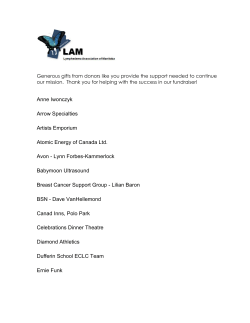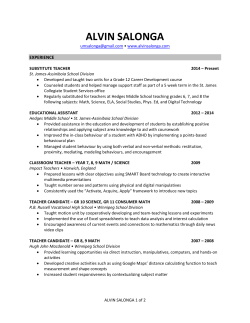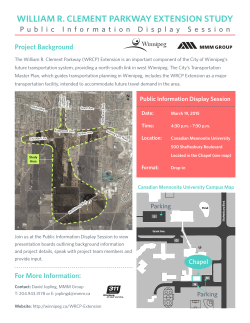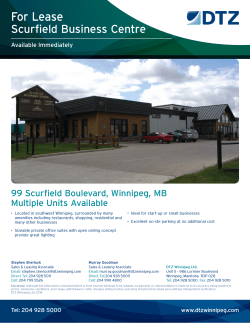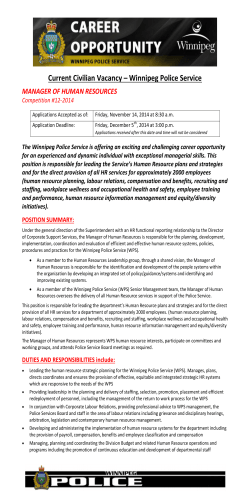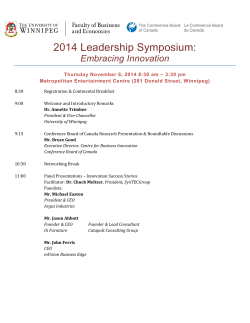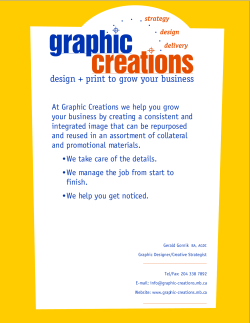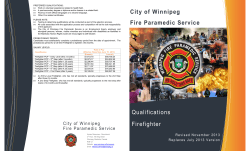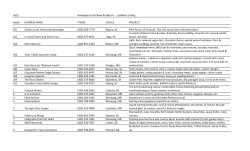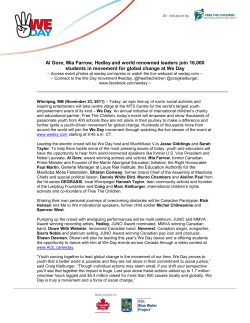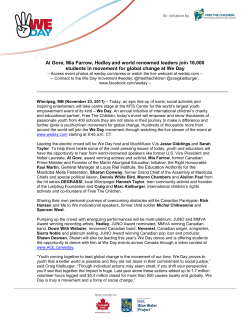
Fried? !nspire! 11
11 VOL. 2.10 ! e r i !nsp summer Health Region g e ip n in W e th r staff working in fo n o ti a rm fo News and in By: Andrea Bodie ? d e i Fr In this issue Feeling hot hot hot……2 Health by design….3 Raising awareness through celebration….5 You’ve got the power…6 …7 Smoke-free is the way to be How to avoid burnout I t can happen after wrapping a big deadline or after a particularly long and stressful day: feeling fried. If that fried feeling isn’t temporary but hanging on with a vice grip …and it’s impacting the way you typically function, you may be experiencing burnout. “You’ll find the most unhealthy workplaces in health care. We don’t take care of ourselves. Chronic exhaustion, cynicism, diminished interest and losing one’s efficiency are warning signs that you’re neglecting to do something you know how to do,” says Dr. Ray Baker, a physician certified in Family Medicine and Addiction Medicine and Medical Director for HealthQuest Canada. The opposite of burnout is being engaged and involved. Compassion fatigue – where you just stop caring – is something that health care professionals need to be wary of. “It’s a sign that you’re starting to numb out,” says Dr. Baker. Burnout has a price. Over the long term, it can impact our attendance at work, our performance and our safety. It puts us at greater risk for coronary heart disease, cancer, depression and substance abuse disorders. “With my nursing background, I’m all too aware that we don’t often think of our own safety as healthcare providers. If we neglect our physical and mental health, we can experience burnout and addictions,” says Arlene Wilgosh, President and CEO of the Winnipeg Health Region. “The fewer people who are sick or injured put less stress on staff. Focus on safety and yourselves and make your work environment the best it can be.” continued on page 8... By Andrea Bodie Feeling hot hot F hot? orecasts are calling for hotter than normal summer temperatures and higher humidity. “It all comes down to the body’s ability to cool itself,” says Kulpreet Munde, for the Heat Alert Response System (HARS) Pilot Project Regional Coordinator. Younger children and adults over 65 are considered vulnerable groups at risk for the combination of high temperatures and high humidity. People who are very active outdoors (such as runners), people who work outside and people with chronic health conditions are also at risk. Know what to look for and what to do Heat exhaustion happens when your body looses too much water and salt. Symptoms include: headache, nausea, muscle cramps, pale/clammy skin, dizziness or fainting, fast breathing and a rapid heartbeat. Sip water in a cool place and lie down. Heat stroke is when your core body temperature is above 40°C. It requires urgent medical attention (e.g. call 911) to avoid permanent damage or death. Symptoms include: headache, red, hot and dry skin, dizziness, confusion, nausea, a rapid and weak pulse and a complete or partial loss of consciousness. While waiting for an ambulance to arrive, move the person to a cool place and sponge the body with cold water. Pilot project on heat The Winnipeg Health Regio n has been an active partne r in a pilot project funded effectiveness of heat alert an by Health Canada to develo d response systems at region p and demonstrate the al or municipal levels. The overall goal is to create a culture of awareness with respect to heat. “Most Cana is slowly and surely chang dians don’t think about hea ing. We need to make sure t,” says Munde. “The climate our attitudes about heat are also changing.” Protect yourself from h eat 1. Stay aware and be pre pared. 2. Stay hydrated. 3. Stay cool and keep ou t of the sun. 4. Take care of yourself and others. No air conditioning? G et creative If you don’t have air cond itioning, it’s still important to keep yourself cool. 1. Find a cool location (su ch as a mall or movie the atre). 2. Visit a local swimming pool. 3. Take cool showers or baths until you feel relief . 2 !nspire! • Summer 2011 r 2011. Inspire Look for our next issue in Octobe hin the is distributed to over 100 sites wit a story, mit sub To . ion Reg lth Winnipeg Hea call 926-1310. contact [email protected] or munications and Inspire is published by the Com Winnipeg Regional Public Affairs Department of the in the loop about news, Health Authority. It keeps staff ion. To request events and happenings in the reg e and address to a copy of Inspire, e-mail your nam [email protected]. Editor: Andrea Bodie ie Lesyk, Mike Daly, Contributors: Eva Kovacs, Am Susie Strachan Editorial Office: Inspire nipeg, MB R3B 1E2 3rd Floor, 650 Main Street, Win region’s intranet Read us online: visit Insite, the e pir http://home.wrha.mb.ca/ins Health by design By Andrea Bodie Lesley Hoy, Clinical Resource Pharmacist WE’RE TALKING ABOUT YOU, AND WHAT YOU DO C an a building really help with controlling the spread of infection, recruiting and retaining staff and creating healthier communities? Yes. You might be surprised at the ways the Winnipeg Health Region’s facilities are contributing to health and wellness. “The investment in a higher quality and better performing buildings with purpose designed spaces leads to more productive and satisfied workforce. This can translate into better productivity and less sick days. In a healthcare setting, this also improves the patient experience,” says Andrew Konowalchuk, Regional Director of Capital Planning. “We’re working to make sure the overall experience for everyone in our buildings is positive.” When end users offer their perspective, the result can be a workspace specifically designed for primary care staff – like the one at 640 Main – designed with an open and integrated team approach. This better facilitates interdisciplinary discussion, which can translate into improved patient care. Wider doorways, grab bars in hallways, accessible community kitchen and textured flooring on the staircases at 640 Main are features the City of Winnipeg recognized with an Accessibility Award in 2010. Incorporating universal design concepts ensures the facility can be accessed by staff and the general public of varying ages and abilities. Capital Planning’s 11 staff – including architects, interior designers and building technologists – are currently juggling about 60 projects. They’re also celebrating receiving Green Globe Certification (receiving a three globe score) for 650 Main and the ACCESS Centre at 640 Main. A green building factors in the amount of daylight, the quality of the air, more fresh air in the buildings, which furniture and finishes are used and minimizing or eliminating harmful gasses. Along with greater energy efficiency and lower greenhouse gas emissions, these facilities are a selling feature when recruiting staff. Did you know? • While the certification process can take up to two years after opening, the Birth Centre, Seven Oaks General Hospital Emergency Department, Victoria General Hospital Oncology and Emergency Departments, ACCESS St. James, Specialized Services for Children and Youth, Misericordia Health Centre Redevelopment, the Aboriginal personal care home, Women’s Hospital Redevelopment Project and the Mental Health Crisis Response Centre have been designed according to the Province’s Green Building Policy. • Education about a facility’s features and how to use them is part of Capital Planning’s role. !nspire! • Summer 2011 3 our y k c e Ch * M R H r Monito rt Rate a e H ’s *That ne 19th u J n o y earl ical up very d timely med e k o w s. ho eive nteers w Marathon rec lated acronym u l o v 0 e er er 30 toba ing-r k e s ot h e the ov rs at the Mani king at runn a t a m r t b a e l h e loo ses t To ce sure runne ch place u es you scrat ssue. ies, we’r r e k k u r j a o n i w m k r to ei ing i t ma yo u r se for th t h a n d n c h a r t s t h a i n a n u p co m respon r shor .ca m .mb a h r w @ inspire yms o hand o re the e acron head? Short e may featu v a h u D o yo t h e i r to u s , a n d w shake e l em p o to e p end th S ? E-mail d a e h r u yo y Release Therap ART Active ial Band ITB Iliotib me l Band Syndro ia b ti io Il S ITB um Heart Rate MHR Maxim unning Related NRR Not R s Plantar Fasciiti PF n and p e, Com ressio Ic t, es R RICE Elevation ed Running Relat RR Fracture SFX Stress uled Rest Day SRD Sched Cross Training XT noted an ur last issue ation. O : te o n se a uscit **Ple onym for Res incorrect acr acronym is “R”. on The correcti athon. ring the mar u d s sk of injury. rn ce n duce their ri edical co re m s to u n o o ri p u se n improve e the most ion can creat ts runners ca st en au fractures h em el ex e at ar e ained at each one. knees, stress tr n and h s o ed ie ly ti n it er ra il in p d y ab sk ro p p eh s, • D d not being l response ca rains, sprain too hard an with medica le cramps, st e, sc u rs u m co s, e er • Pushing th st apists, bli ns on e, physiother r anything – cu fo es ere 23 statio y R w d d e a er re an s Th a w ecialists. • earch and other sp sponse team Manitoba S re ts s, l is ic a tr ic ed ia ed d o am m p ar • The hysicians, students, p tion. assistants, p , paramedic an ts ci en si d y hand towels. u h p st l and even fric s, o itioner h scho lankets and ct b ig h ra s, p b es e d ru rs u sc u cl n h , in ors, nurses nse team wit • The team ts, chiropract edical respo is m e ap th er th ed c id ti v athle h Region pro nipeg Healt in W e Th • now? k u o y d i D ! t u o b a & T U O Health r u o f o e nsid A view i Region Jan Schmalenberg (Winnipeg inmotion), Arlene Wilgosh (President & CEO) and Sande Harlos (Medical Officer of Health) share a chuckle as they come out of the Giant Colon at the Red River Ex. Jiabo Fang, Feng Ling and Wen Win Shen, visiting nursing professors from China, learned about how things work in our Region from Brenda Johnson, Colleen Orton, Michael Zhang, Laura Anning and Kristin Ludwick. 4 !nspire! • Summer 2011 Passionate about HR (and community), Ivy Hung, Lisa Mendez, Joanne Prescott, Michelle Burr and Frances Maestro from 650 Main before they contributed to the WRHA Strokebuster team for the Big Bike Race. Raising awareness through celebration By Amie Lesyk T he Winnipeg Health Region celebrated National Aboriginal Day this year with events held at various health-care facilities throughout the week of June 20 – 24. This new regional promotion will take place each year around National Aboriginal Day (June 21) with a goal of raising awareness at health-care sites. “We found there was a need for awareness. There are many who do not know what National Aboriginal Day is or why it’s celebrated,” says Dr. Catherine Cook, Vice President Population and Aboriginal Health for the Winnipeg Health Region. “We feel the week of events is a good opportunity for everyone to gain knowledge and to come together in doing so.” This year, several celebrations such as performances with hoop dancing and drum groups and CEO Grand Rounds in Aboriginal Health, took place throughout the Region. The week-long celebration is one of many initiatives the Region has put in place to create a more OK – - patient education - job postings On Hold – - advertising - publications culturally competent health-care system. The need for increased cultural awareness is for several reasons, including the fact Winnipeg has the largest urban Aboriginal population in Canada and at times up to 40 per cent of our urban hospital patients may be Aboriginal. Ensuring staff has access to events and information that improve understanding of First Nations, Métis and Inuit peoples is one way the Winnipeg Health Region is achieving its goal. Further opportunities to learn about Aboriginal cultures in Manitoba are available through Aboriginal Health Programs – Health Education. Visit www.wrha.mb.ca/ aboriginalhealth. s on Pre-election restrictionhing advertising and publis Region Act, the Winnipeg Health ces an Fin s on cti Ele the th July 6 – To ensure compliance wi ave, Inspire) on hold from (W ing sh bli pu d an ing will be placing advertis unications, news may apply to web comm ce pla in ns tio tric res e Th October 4, 2011. s. Tender proposals (for d speeches/presentation an es zin ga ma s, ure ch alth or releases, bro ation (also about public he uc ed nt tie pa d an gs stin po ongoing programs), job n. For details, visit Insite. table under the legislatio ep acc ly ral ne ge are ) ety saf !nspire! • Summer 2011 5 By Eva Kovacs You’ve got the Power Thrive in the face of change How do you thrive in a changing workplace? In the changing world, we must change. That was Barb Fry’s answer to the question, which she presented to more than 320 Winnipeg Health Region staff at First Line Managers’ Day on May 31. While there may be the desire to have things stay the same, it’s simply not possible, says Fry. “Certainly change is not easy and many of us struggle with that. There are things we encounter that make us feel like things are spinning out of control and we wonder, is it ever going to end? Be comforted by the fact that there isn’t a template for where you’re at, because we’ve never been here before.” Along with identifying the drivers for change – Global economics and technology – Fry pointed out the new “normal” is about consolidating and restructuring. That creates a growing need for flexibility, innovation and creativity. How to thrive in a changing workplace se Not a Job o rp u P a le p o Pe g in iv G ief Massenhoven, VP and Ch eo John Van Check out the Youtube vid sentation on sh r ared as part of his pre Human Resources Office Not a Job. Giving People a Purpose tivates us. ising truth about what mo It’s called Drive: The surpr llion views. received more than 5.7 mi The 11 minute video has be and search it by logging onto Youtu tch Wa y? wh ow kn to nt Wa ‘rsa animate-drive’. 6 !nspire! • Summer 2011 Change is unavoidable. Fry ’s tips for thriving in a changing workplace: Tip #1 – Choose your at titude wisely. Are you thriving or mere ly surviving? Tip #2 – Take care of yo urself. What are you doing to physically, m entally, spiritually rejuvenate? Tip #3 – Give yourself th ree gifts: time, a positive attitude and co urage to create your future. Tip #4 – Expect, live and model respect. How are you being respe ctful for self, others and your workplac e? Tip #5 – Don’t wait for ot hers to change – you go first! The best wa y to predict the future is to create it. e e r F e k o m S is the way to be By Mike Daly I f you like your air free from the dangers associated with tobacco smoke, two recent announcements likely brought a smile to your face. On May 25, The City of Winnipeg passed its Outdoor Smoking By-law that prohibits smoking anywhere on our property and within eight meters of any entrance. Anyone found smoking in a restricted area may be ticketed and fined by a City of Winnipeg By-law Officer. In a similar move, the Winnipeg Health Region has refreshed its Smoke-Free Policy, which now includes a clearer expectation of management and staff to enforce and adhere to this policy. “Creating a healthy, smoke-free environment around our health facilities and offices just makes sense,” said Winnipeg Health Region President and CEO Arlene Wilgosh. “It’s not only the right thing to do – it’s a commitment we are proud to make.” People found smoking on Region property or near doors or air intakes are now being asked to move away to finish their cigarettes. Beginning in July, Notices of Enforcement will be issued to people smoking where prohibited. However the Region’s renewed focus on being smoke-free is about more than rules, regulation and policy: it’s about taking action to better protect the health of smokers and nonsmokers alike. “This benefits everyone”,” says Dr. Sande Harlos, Medical Officer of Health for the Region. “Non-smokers feel healthier, but it helps smokers too. Our patients recover better if they stop smoking while in hospital. So it’s our job to make sure patients know they can be smoke-free and comfortable on nicotine replacement while they are in our care, not out on the sidewalk with gowns flapping in the wind”. “And when you think that nearly half of all smokers will try to quit over the next year, not having to walk through a cloud of smoke to come to work has to be a good thing” she said. “If you know a co-worker trying to quit- cheer them on”. You won! Congratulations to Lorna Doolan, Lorraine Friesen and Wendy Seidel who won a 2GB memory stick for entering our Vision Mission Values giveaway. Account for smoking Health Care Spending Staff can use their HEB a physician. Anyone ograms if prescribed by cessation drugs and pr it smokershelpline.ca : 1-877-513-5333 or vis ine lpl He ers ok Sm ll ca n ca wrha.mb.ca/ on our website at www. le ab ail av is s rce ou res A list of bacco/resources.php. healthinfo/preventill/to !nspire! • Summer 2011 7 (Fried – how to avoid burnout)…continued from page 1 The solution “My boundaries tell me what I’m responsible for, what you can’t touch. If you’re a victim of burnout, you’ve got lousy boundaries,” says Dr. Baker. Many health care professionals learn the skills that make them good at what they do – taking care of others, helping others, being overly responsible – in dysfunctional or alcoholic homes. “Boundary injuries can occur during a critical attachment phase with inconsistent rules and crazymaking,” says Dr. Baker. “Adults from alcoholic homes are attracted to health care professions like lemmings to the sea.” There are two boundary problems to watch out for: being a doormat who never protects your boundaries or being a steamroller who doesn’t recognize other people’s boundaries. Learning boundaries is an ongoing process. Reading concepts is a start but setting (and sometimes reinforcing or re-establishing) boundaries and articulating those is a skill that we can continue to build over time. “Practice setting those boundaries. If I’m going to survive, I need to learn to say no – that’s a boundary word,” says Dr. Baker. “Work on boundaries all the time: say what you mean, mean what you say and don’t be mean when you say it.” learn to say no… What burnout looks like You could be approaching burnout (or you could be burnt out) if you’re: 1. getting sick more often 2. feeling less inclined to go to work WINNIPEG’S HEALTH AND WELLNESS MAGAZINE SuMMEr 2011 Protect your health – avoid burnouhatt’s important and protect 1. Remember w ies and goals. your values, priorit ng skills. tice boundary setti 2. Learn and prac y ntial – set a health 3. Balance is esse keep. schedule you can minutes at least 4. Exercise for 30 k. four times per wee sterday t moment – not ye 5. Be in the presen s on the now. or tomorrow – focu ion for ance and compass 6. Practice accept yourself and others. ilar ople who have sim 7. Connect with pe ies. interests and priorit ng every day. 8. Create somethi and mour (and laugh!) 9. Look for the hu beauty in life. ning. 10.Never stop lear About the Safe rence Healthcare Confe ce had care Conferen The 4th Safe Health er ance to date as ov the highest attend m throughout 200 participants fro at the Victoria Inn Manitoba gathered th. on May 9th and 10 3. more moody and irritable 4. feeling emotionally dulled* 5. performing erratically at work 6. less reliable that you usually are INSIDE Ten questions: heart health How to prevent a headache 7. isolating yourself from typically supportive interactions/relationships 8. absences at work are getting longer (later stages) *Health care professionals may be great at thinking but not great at feeling, given the nature of our work. This can also mean we may miss warning signs where emotions are concerned. 8 !nspire! • Summer 2011 Your guide to summer fun Making a difference All about probiotics Where to find fresh veggies & fruit Trauma Season: how to stay safe this summer THE GRADUATES Catch the next Wave! logist. Three want One wants to be an onco nts to be a health to be nurses. A fourth wa duates of the High technologist. All are gra , in 2007, the program ip program. Established studying School Medical Internsh h School to spend time Hig rth Ea the of ren ild enables students at Ch ng credit toward their h Sciences Centre, earni alt He d an nic Cli Am n this innovative at the Pa t class to graduate from firs the et Me . on ati du gra high school gazine is available at edition of Wave. The ma city. You program in the summer are facilities around the h-c alt he d an s ler sel ok McNally Robinson Bo www.wrha.mb.ca. can also read it online at Meet the first students to complete a medical internship designed to boost the number of Aboriginal health-care workers in Manitoba
© Copyright 2025
